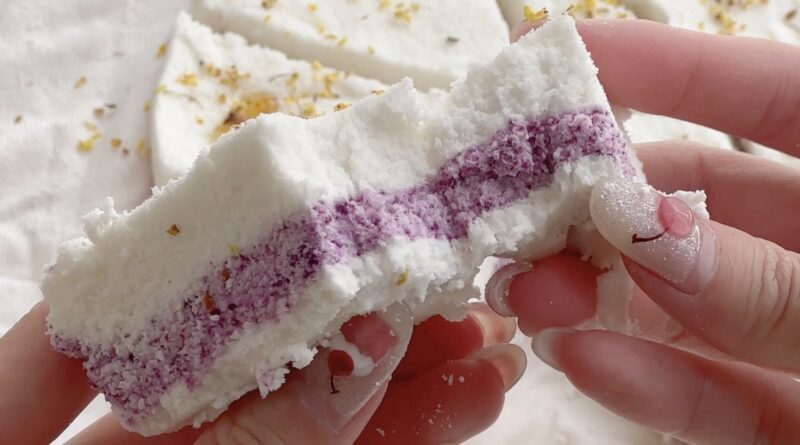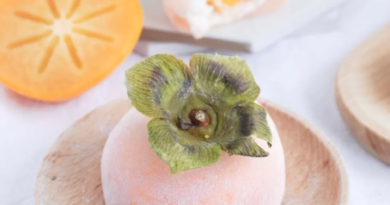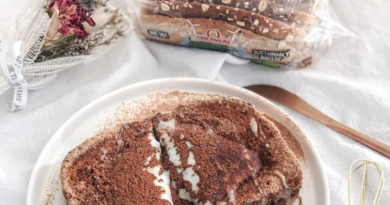Purple Yam Steamed Rice Cake (Baekseolgi)
Baekseolgi (Korean Steamed Rice Cake) is one of the easiest traditional desserts to make at home – no oven needed, just simple ingredients like rice flour, sugar, and a steamer! While classic baekseolgi is delicious plain, I love adding purple yam powder for color and pairing it with homemade osmanthus jam for a fragrant twist that’s popular during China’s Mid-Autumn Festival.
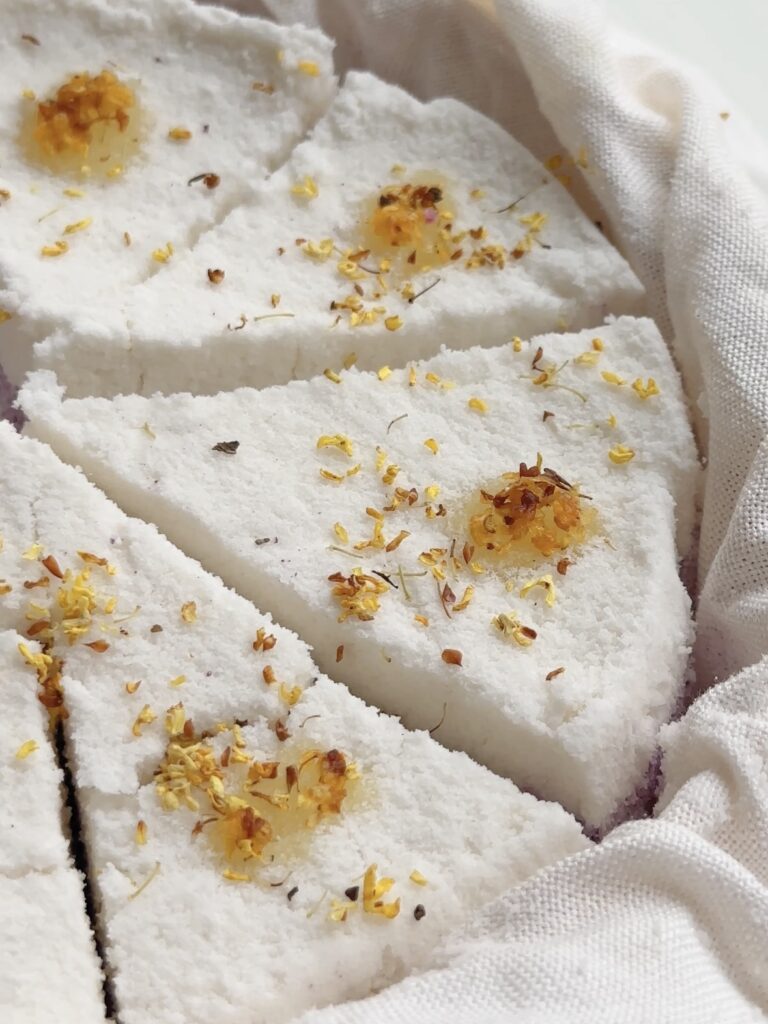
What is Baekseolgi?
Baekseolgi (백설기) is a classic Korean steamed rice cake known for its delicate, snow-white appearance and subtly sweet flavor. Made from finely milled rice flour, it has a uniquely soft yet slightly chewy texture that sets it apart from other dense or sticky rice cakes. Traditionally served during celebrations and ancestral rites, baekseolgi acts as a blank canvas that pairs beautifully with various toppings – which is why I’m enhancing mine with vibrant purple yam powder for color and fragrant osmanthus jam for flavor.
While the purple yam powder gives this version its gorgeous lavender hue, I want to be honest – it doesn’t contribute much flavor on its own. That’s why the pairing with osmanthus jam is so perfect! The floral, honey-like sweetness of the jam complements the mild rice cake base beautifully.
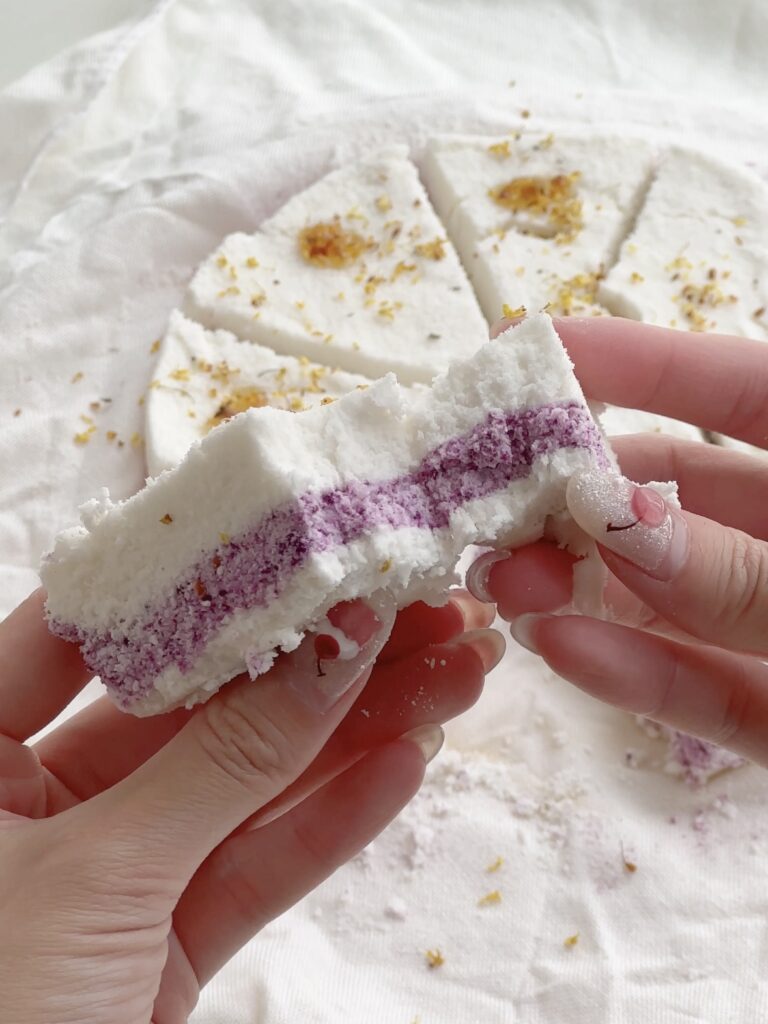
Baekseolgi’s Rise in China’s Mid-Autumn Festivals
While not a traditional Chuseok food in Korea, baekseolgi has become a popular treat in China during the Mid-Autumn Festival. This shift makes sense—osmanthus, the star ingredient, blooms in autumn and is deeply tied to the season. For centuries, Chinese culinary traditions have incorporated osmanthus into mooncakes, sweet wines, and teas – its honeyed floral aroma symbolizing prosperity and the sweetness of family reunions. The rice cake’s mild, chewy texture pairs perfectly with osmanthus jam, offering a lighter alternative to rich festival desserts. As cultural exchanges grow, this Korean classic has found a sweet spot in China’s autumn celebrations.
Key Ingredients
Steamed Rice Cake (Baekseolgi) Base
- Rice flour – The foundation of baekseolgi, giving it its signature soft texture
- Glutinous rice flour – Adds that delightful chewiness to complement the fluffy base
- Sugar – Balances the subtle flavors
- Salt – Enhances all the flavors
- Water – Creates the perfect steaming consistency
- Purple yam powder – Provides that gorgeous natural lavender hue
- Homemade osmanthus jam – The star flavor component with its floral sweetness
- Dried osmanthus – for presentation
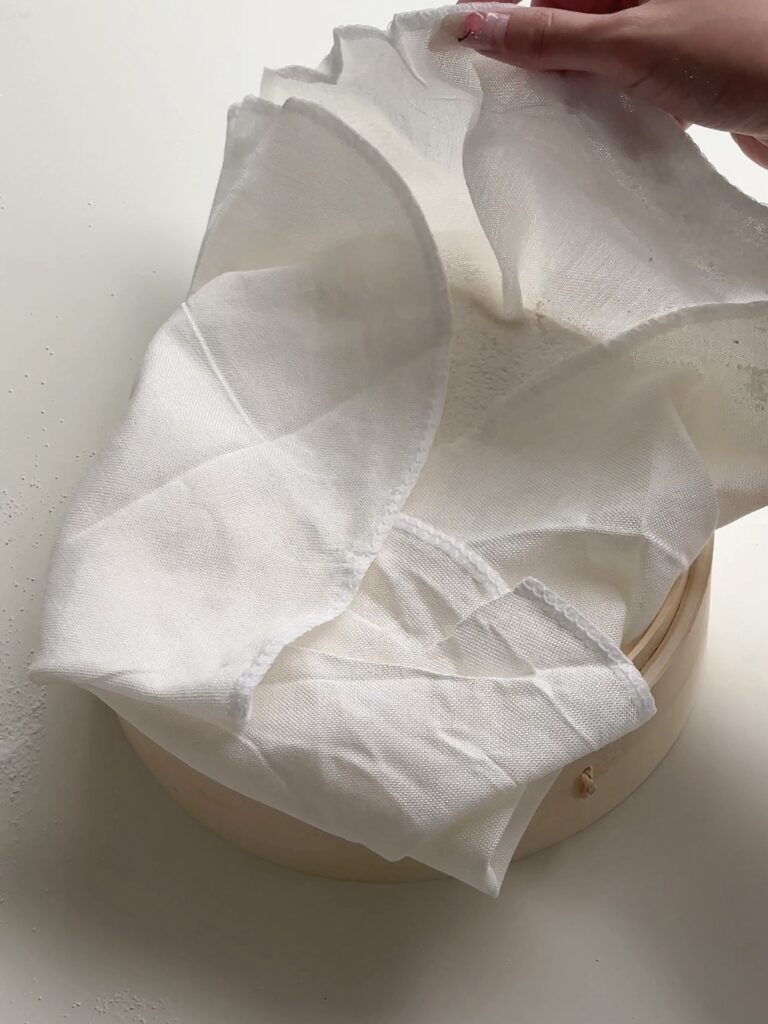
Key Tools for Steaming Baekseolgi
Bamboo Steamer
The best choice for steaming baekseolgi, as it allows steam to circulate evenly for a fluffy texture. A deeper bamboo steamer is my personal favorite, but for this recipe, I used a regular steamer, which worked perfectly fine — the only difference is that the final cake will be a little shorter in height.
- Replacement option: A cake mold with no bottom can also work as a steamer insert.
- Avoid: Glass containers — they trap too much moisture, and the mixture won’t steam properly, leading to a dense, uneven texture.
Cotton Steamer Cloth (or Cheesecloth)
Cotton steamer cloth prevents sticking while keeping the rice cake’s surface smooth. It should be large enough to drape over the edges of your steamer.
Creative Flavor Variations for Baekseolgi
While osmanthus jam makes a beautiful pairing, baekseolgi’s mild flavor welcomes endless creative twists. Here are some delightful alternatives to try:
Floral & Fragrant Options
- Matcha powder – For earthy, tea-infused baekseolgi with a vibrant green hue
- Rose jam – Adds a romantic, perfumed sweetness
- Chrysanthemum syrup – A delicate herbal note popular in Chinese desserts
Nutty & Earthy Variations
- Black sesame paste – Rich, toasty flavor with striking dark contrast
- Red bean filling – A classic Korean pairing with sweet, comforting notes
Tips for Perfect Baekseolgi
- Moisture control is key: The flour mixture should feel like damp sand—moist enough to clump briefly but crumbly when touched.
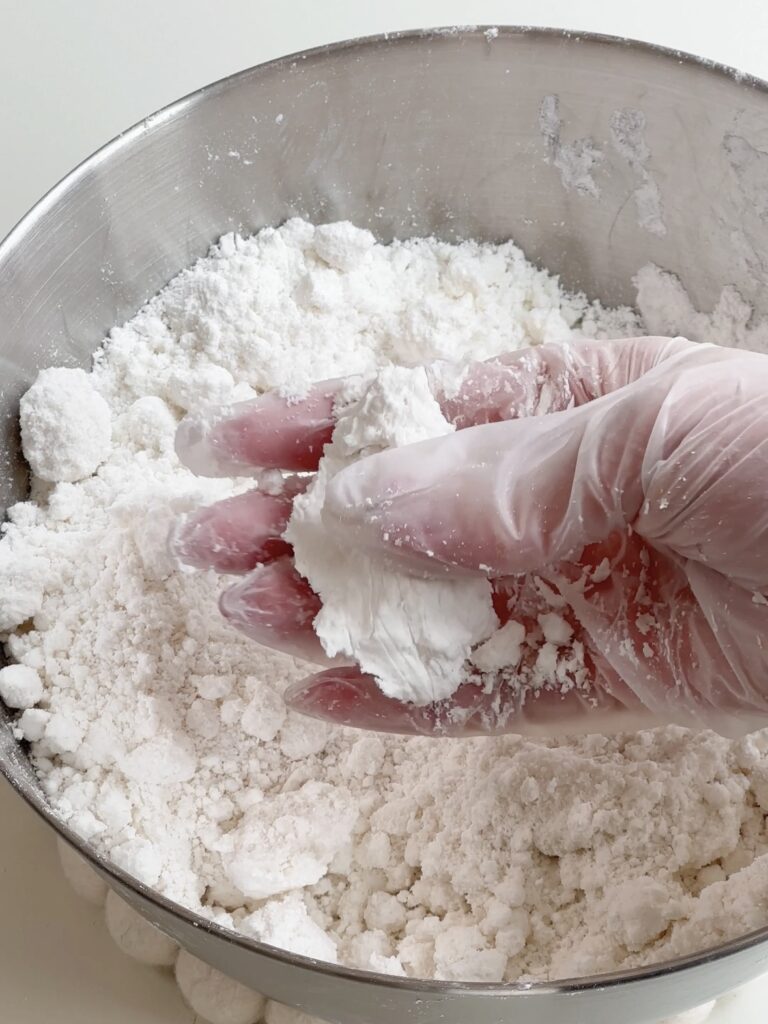
- Sift multiple times: This ensures a fine, lump-free texture for a smooth cake.
- Steam with care: Avoid lifting the lid during steaming to prevent a sunken texture.
- Serve warm: Baekseolgi tastes best fresh. If it firms up after cooling, simply steam it again for 5–10 minutes to restore its soft, bouncy texture.
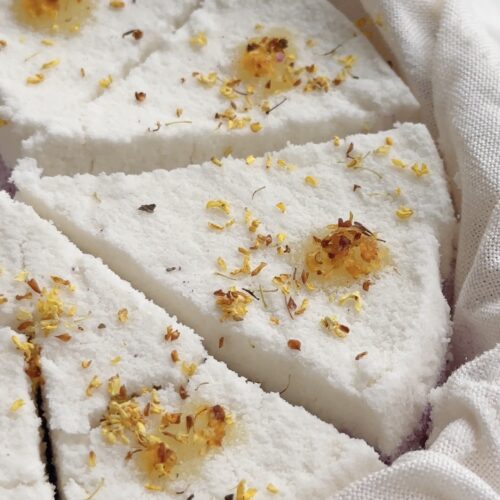
Purple Yam Steamed Rice Cake (Baekseolgi)
Equipment
Ingredients
Baekseolgi
- 300 g rice flour
- 120 g glutinous rice flour
- 65 g sugar
- 225 g water
- 1 tbsp purple yam powder
Osmanthus Jam
- 300 g sugar
- 150 g water
- 5 g dried osmanthus
- 30 g lemon juice
- 1 g salt
Instructions
Prepare the steamer
- Fill a wok or wide pot with about 2 inches of water. Bring to a gentle boil.
Prepare the cake "powder"
- In a bowl, whisk together rice flour, glutinous rice flour, sugar, and salt.
- Slowly pour in the water while mixing with your hands or chopsticks, ensuring all flour is evenly moistened. The goal is a damp, sandy texture—not a wet batter.
- If you find wet lumps, rub them gently between your palms to break them apart. Continue mixing until the texture is uniform and free of dry spots.
- Squeeze a handful of the mixture—it should hold its shape when pressed together but crumble lightly when poked. If it’s too dry and won’t clump, add water, 1 teaspoon at a time, and mix well. If it’s too wet (sticks to your hands aggressively), sprinkle in a bit more rice flour. The ideal texture should feel like damp sand—it holds together briefly when squeezed but breaks apart easily. This ensures the baekseolgi steams up light and fluffy.
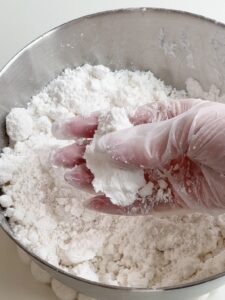
- Sift the mixture 2–3 times for a fine, lump-free texture.
- Transfer one-third of the sifted mixture into another bowl. Add purple yam powder and whisk until evenly combined to prevent clumping.
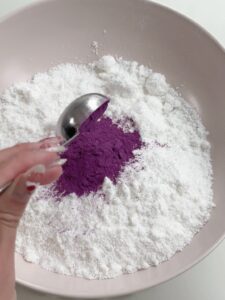
Steaming
- Line a bamboo steamer with a cotton steamer cloth or cheesecloth, letting the fabric drape over the edges.
- Spoon in the white flour mixture up to one-third of the steamer and gently level the surface without pressing down.
- Add the purple yam mixture as the middle layer, spreading lightly to keep it airy.
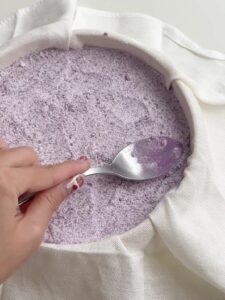
- Top with the remaining white mixture, again avoiding compression.
- Use a knife to cut through the unbaked mixture to create clean portions (squares or triangles). Sprinkle dried flowers on top.
- Lightly fold the overhanging cloth over the surface (like a blanket) to trap steam. Cover with the bamboo steamer lid.
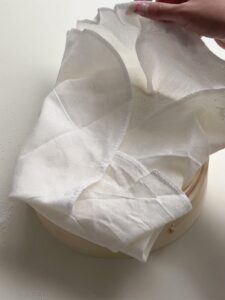
- Gently set the steamer into the pot, making sure the water doesn’t touch its base. Steam on high heat for 45–50 minutes. Prepare osmathus jam during this time.
- Turn off the heat, leave the lid closed for 5 minutes, then open slightly to let steam escape for another 2 minutes. Serve warm with osmanthus jam. Note: the cake will firm up once cold.
Prepare the osmanthus jam
- In a small pot, combine sugar and water. Bring to a boil without stirring until the syrup turns light yellow.
- Reduce to low heat and simmer for 3 minutes.
- Add dried osmanthus flowers, lemon juice, and salt. Stir gently.
- Bring back to a boil, then lower the heat and simmer for another 10 minutes.
- Transfer to a clean mason jar. The jam will thicken as it cools.
We are a participant in the Amazon Services LLC Associates Program, an affiliate advertising program designed to provide a means for us to earn advertising fees by linking to Amazon.ca and affiliated websites.

